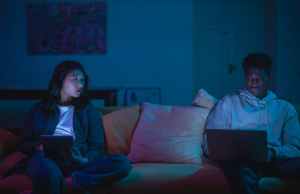We’re all familiar with the silent frustration of another meeting (that could have been an email) popping up on our calendar. What’s less clear? Knowing when our reaction to an irritating situation is healthy and when it enters the territory of anger issues. “Ultimately, anger isn’t the problem, it’s often…
Mental Health Topics
If you’re questioning whether your anxiety is normal, you’re not alone. The truth is, anxiety itself is completely normal. It’s a future-focused emotion that helps us prepare for potential challenges. Anxiety is the feeling that prompts you to buckle your seatbelt, study for an exam, or rehearse before a big…
There’s something uniquely satisfying about absorbing wisdom while you’re doing something else—whether you’re commuting, cooking dinner, or taking a walk. Podcasts let you gain insights and inspiration or simply be entertained by real voices without having to stare at another screen, making them perfect for our overstimulated lives. There’s no…
Want to talk to a therapist?
Start working with one of our top-rated providers. We have availability now and accept most major insurances.
Has an old photo ever stopped you in your tracks, flooding you with memories so vivid you could almost step back into that moment? Or maybe a familiar song came on the radio and suddenly you were transported to a different time, a different version of yourself. That rush of…
People with narcissistic tendencies can be incredibly charming when you first meet them, but they’re often manipulative and disrespectful to those close to them in order to get what they want. While narcissists can change if they seek help and genuinely commit to improving themselves, it’s extremely difficult for them…
Anxiety has a way of taking your emotions from calm to overwhelming in what feels like seconds. Whether you’re experiencing persistent worry that won’t quiet down or full-blown panic attacks, anxiety can make you feel like you’re losing control of your thoughts and body. That’s exactly why having reliable coping…
Want to talk to an anxiety therapist?
Start working with one of our top-rated providers. We have availability now and accept most major insurances.
Dawn Laven (not her real name) and her husband have had sex maybe twice in 10 years. She blames the most recent drought on the discomforts of menopause, but the spark left her 27-year marriage long before that. “We’re just friends, roommates, people who do life together,” Laven says. “There’s…
We’ve all encountered someone who seems overly self-focused—maybe they always steer conversations back to themselves or make decisions that seem pretty self-serving. It’s tempting to call that behavior “narcissistic,” especially since the term has become so common in everyday conversation. But there’s actually a crucial distinction in psychology: having narcissistic…
Picture a jar full of marbles: Each marble represents a difficult feeling or emotion—grief, anger, or guilt, to name a few. Now, imagine the last person who upset or hurt you: They knock the jar over, the glass shatters, and the marbles spill out all over the floor. They quickly…
Trying to figure out mental health care can feel overwhelming. There are therapists, counselors, psychologists, psychiatrists, and psychiatric nurse practitioners—and they all seem to do similar things. Add in all the licensing abbreviations that vary by state, and it’s easy to feel lost before you even start looking for help….
If you’ve ever wondered whether your relationship could handle more openness—or if you’re already navigating the complex world of multiple partners—you’re not alone. More couples are exploring open relationships than ever before, yet many struggle with the fundamental question: What does it actually take to make this work? While trust,…
Hyperfixation is a unique state of mind that goes far beyond a simple hobby or interest. Unlike casual interests, hyperfixations are intense, obsessive, and persistent—often taking precedence over everyday tasks and responsibilities. While commonly linked to conditions like ADHD, hyperfixation can happen to both neurodivergent and neurotypical people, shaping how…

Trending Categories
- Relationships
- Self-Improvement
- Feelings & Emotions
- Research
- Beginning Therapy
- Disorders
- Anxiety
- Mental Health Awareness
- Media Use
- Children, Teens, & Adolescents
- Parenting
- Depression
- Work & Careers
- Psychology
- Stress
- Communication
- Self-Care
- Coping Skills
- COVID-19
- Family
- Grief & Loss
- Health & Exercise
- Personality
- Sleep
- Alcohol & Drugs
- Medication
- Addiction
- Ask a Therapist
- Trauma
- ADHD
- Loneliness
- Psychiatry
- Power & Control
Mental Health Disorders (DSM-5)
- Adult Antisocial Behavior
- Acute Stress Disorder
- Adjustment Disorder
- Agoraphobia
- Alcohol Use Disorder
- Anorexia Nervosa
- Antidepressant Discontinuation
- Antisocial Personality Disorder
- ADHD
- Autism Spectrum Disorder
- Avoidant Personality Disorder
- Avoidant Restrictive Food Intake Disorder
- Binge Eating Disorder
- Bipolar 2 Disorder
- Body Dysmorphic Disorder
- Caffeine Withdrawal
- Cannabis Use Disorder
- Cocaine Use Disorder
- Conduct Disorder
- Cyclothymic Disorder
- Delusional Disorder
- Dependent Personality Disorder
- Excoriation Skin Picking Disorder
- Exhibitionistic Disorder
- Fetishistic Disorder
- Gambling Disorder
- Gender Dysphoria
- Generalized Anxiety Disorder
- Genito-Pelvic Pain Penetration Disorder
- Histrionic Personality Disorder
- Hoarding Disorder
- Illness Anxiety Disorder
- Inhalant Use Disorder
- Insomnia
- Kleptomania
- Language Disorder
- Major Depressive Disorder
- Male Hypoactive Sexual Desire Disorder
- Narcissism
- Nightmare Disorder
- Obsessive Compulsive Disorder
- Obsessive-compulsive Personality Disorder
- Panic Disorder
- Paranoid Personality Disorder
- Pedophilic Disorder
- Posttraumatic Stress Disorder
- Pyromania
- Rumination Disorder
- Schizoid Personality Disorder
- Schizophrenia
- Schizophreniform Disorder
- Selective Mutism
- Separation Anxiety Disorder
- Sexual Sadism Disorder
- Social Anxiety Disorder
- Tobacco Use Disorder
- Tourettes Disorder
- Trichotillomania Hair Pulling Disorder
- Uncomplicated Bereavement
- Unspecified Personality Disorder
- Unspecified Sexual Dysfunction












